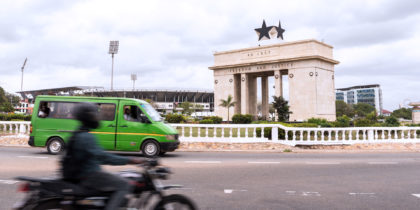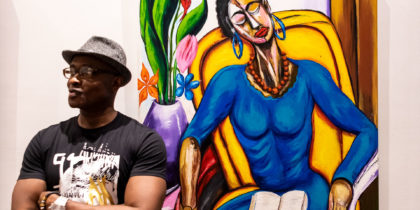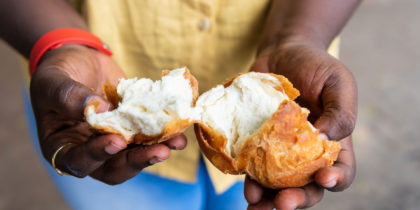“Akwaaba!” That friendly greeting floated over to me several times from strangers bearing wide smiles upon my arrival in Ghana’s capital city, Accra. Casually denoting “welcome,” this nuanced word actually means “you’re welcome to this place” in various dialects of the Akan language.
This place …
To fully appreciate Ghana’s current renaissance is to understand the dark history that played across its coastlines for centuries.

In 2019, Ghana celebrated the “Year of Return,” marking 400 years since the first enslaved Africans were taken off its shores from places such as Portuguese trading outpost Elmina Castle and nearby Cape Coast Castle. The peeling white walls of more than three dozen 15th- and 16th-century castles dot Ghana’s sandy coastline and stand as stark reminders.
This global invitation brought “home” thousands of people of African descent from various diasporas around the world, with folk festivals, music concerts and educational conferences.
Today, there’s an understated elegance and self-confidence that runs beneath the pulsating heart of one of West Africa’s most formidable cosmopolitan cities. Exploring Accra requires a quick geographic overview and city tour before diving deep into various aspects of its dynamic culture, such as visiting contemporary artists and fashion designers, indulging in modern takes on traditional gastronomy, and sampling the nightlife centered around the district of Osu.
Before planning your trip, check for travel restrictions and closures.

Ghana’s history is etched across its landscape. Those whispered stories can be found in monuments such as Kwame Nkrumah Memorial Park, which houses the mausoleum and burial place of Kwame Nkrumah, the first prime minister and president of the Republic of Ghana after its independence from Britain in 1957.
This independence is commemorated annually on March 6 with military parades in Independence Square, also known as Black Star Square, which holds monuments, arches and stadium seating for 30,000-plus people.
“Since its conversion into a metropolis, Accra is turning out to be one of the most vibrant on the continent,” says travel expert and local son PaJohn Bentsifi Dadson, head of Ghana’s National Convention and Visitors Bureau and the creative mind behind the Wango Wango travel movement, which encourages Ghanaians to explore their own backyards. “To meet Accra is to see its art, taste its food and learn its history.”
The Bold and the Beautiful
Whether experiencing the dizzying hustle of traditional Makola Market or haggling for everyday-wear made from traditional kente fabric, batik or tie-dye at the Accra Arts Center — one of the first things you’ll notice is the unmissable Ghanaian style. Traditional textiles have been transformed into chic contemporary clothing while prioritizing sustainability and enriching local communities during their creation.
Accra’s street style is firmly rooted in cultural preservation, and exploring the city through the eyes of its cosmopolites showcases its diversity and beauty in a whole new way. And the best part is you can enjoy local niche tours organized by creatives and visionary entrepreneurs.
People in Accra are doing an incredible job of taking cues from traditional culture and blending it with what’s next.
Cheraé Robinson; CEO, Tastemakers Africa
“People in Accra are doing an incredible job of taking cues from traditional culture and blending it with what’s next,” says Cheraé Robinson, CEO of Tastemakers Africa, which provides authentic and refreshing ways of exploring the city with locals. “Whether it’s food, design, fashion or music—that melding of worlds is what you feel on a Tastemakers experience.”
And it is on a Tastemakers “Art Meets Fashion” tour that I met my vibrant guide Sharifah Issaka, who was wearing a billowing hand-dyed batik robe. Issaka is one of three sisters behind family-run KOFIE (which means “go home” in Twi and is pronounced koh-fee-ay), a design house offering contemporary African homeware and lifestyle products.
Their handcrafted batik robes made by local artisans have graced the likes of supermodel Naomi Campbell. Together, Issaka and I visited some of Accra’s most cutting-edge artists, stylists and designers.
A foray into Jamestown and the La district brought us to the studio of artist, performer and sculptor Serge “Attukwei” Clottey, best known for his groundbreaking installation called “Afrogallonism.” He explores the relationship between yellow plastic jerry cans used for moving petrol, then subsequently water, and their environmental impact on local residents over time. His performance installations are political commentaries on pollution, waste and our impact on the environment.
Then there is Glitz Africa Style designer of the year Aisha Obuobi, the woman behind iconic Ghanaian fashion brand Christie Brown, which uses traditional fabrics to create haute couture styles . Heavy necklaces fashioned from traditional fabric share space with dresses and gowns cut from folk textiles in her boutique storefront frequented by Afua Rida, one of Ghana’s top fashion influencers, among others.
Accra’s contemporary designers and stylists draw inspiration from various sources. For Daniel Mawuli Quist, the renowned artist and stylist behind De FortyFive Lifestyle Studio, his current medium of expression is through “garment” in all its forms, from textiles to felt.
“Right now, I am interested in felt hats that I find while thrifting,” says Mawuli Quist. “They become more interesting when I start looking into their make, brands, where they come from and which time periods they were created.”
His vintage collection of hats, which he has used to style some of Ghana’s top performing acts in music videos, date as far back as the 1940s and 1950s. “Whether it’s a fedora, trilby or Popeye hat, I reshape and remake them for sale.”

His studio is a treasure-trove of antique wearables—from funky eyewear and batik T-shirts made from custom stamps to 80-year-old traditional guinea brocade fabrics.
Community empowerment is an underlying theme you’ll find as you explore Accra’s thriving fashion and design scene. When it comes to sustainability, Studio One Eighty Nine (Studio 189) is a lifestyle brand and social enterprise that commissions local artisanal communities.
Founded by actress Rosario Dawson and Abrima Erwiah, the brand supports traditional tie-dye, batiking and kente-weaving specialists with storefronts in both Accra and New York.
La Maison is a boutique design store and art gallery space beautifully curated by Nada Moukarzel that sells African-themed art and decorative items. It showcases more than 40 local talents alongside international designers. Think handblown glass and decorations, eclectic furniture and delicate vases.
All ideas come from seeds, and with proper nutrition, they become something much bigger.
Essie Blankson-Turner; Co-founder, AMBA
For Lokko House and Elle Lokko designer and curator, Stefania Manfreda, her signature Lokko House was started over a decade ago as a brand selling creative T-shirts about empowerment and Ghanaian pride.
“But once the internet became more accessible, other artists began to open their eyes to possibilities for selling and promoting their work,” says Manfreda. “So we began curating and stocking other brands that are doing a whole different bunch of things representing contemporary Ghana.”
Lokko House stocks a mix that ranges from postcards and bow ties to African dolls and fabric-covered journals, while Elle Lokko focuses on clothes, accessories and beauty products for women.
The same collective thread can be seen in online pop-up boutique AMBA. “Amba means seed,” explains co-founder Essie Blankson-Turner. A serendipitous meeting at a restaurant with her business partner Jessi Ashanti led to the creation of Amba.

Both women have roots in Ghana and grew up with the very fabrics and textiles that have inspired their range of goods—from cushion covers and throws to headscarves and other accents.
“We also support local female businesses by sourcing all our materials directly from women in Ghana, especially those selling at Makola Market,” says Blankson-Turner. “All ideas come from seeds, and with proper nutrition, they become something much bigger.”
Then there is Art 233, a collective of eight legendary Ghanaian artists—Nii Mills, Yaw Safori, Betty Acquah, Emmanuel Adiamah, Amarkine Amarteifio, Wiz Kudowor, Rojo Mettle-Nunoo and Sami Bentil—who exhibit vibrant work ranging from realism and dotillism to abstract and mixed media within the elegant airy spaces of the Accra Marriott Hotel.
“We have uniquely distinct styles within the group, and we’re different artists with different persuasions. Yet our collective work is a reflection of our worldview as Africans,” says Mettle-Nunoo. “Our work is a reflection of our commentary on society.”
Food Traditions and Fusion Tastes
Getting beneath a city’s food culture means crawling its street-food scene to get a taste of what has sustained its residents for decades. Few people know Accra’s belly better than food entrepreneur Jay Gyebi of Mukase Chic. From running her food catering company and cooking classes to organizing a Jollof Festival, to name a few endeavors, Gyebi focuses on highlighting African ingredients, flavors and spices, including the history behind their importance.
Through Tastemakers Africa, my first stop with Gyebi was for red-red at a local chop bar called God Reigns Beans. Red-red is a deceptively filling local dish of black-eyed beans cooked in palm oil and topped with succulent slices of fried plantains. As for the name God Reigns Beans, this 60-plus-year-old multigenerational joint attributes its decades-long success to God’s blessings.
As we dug into our red-red, a fellow diner confessed to me that he’d first visited the chophouse 14 years earlier on a trip to Accra and had returned to see if it was still as good as he’d remembered. His empty plate was the only confirmation we needed. “That’s the beauty of food and what it means to you,” says Gyebi. “When we say food is culture, this is what we mean. Food that you have fond memories of and that means something to you.”

At nearby Peace Chop House, you can watch local cooks stirring large cauldrons as they make banku, a tarty, doughy starch made from equal parts fermented corn and cassava and often served with a variety of soups and stews.
Other stops along our crawl included cooling off in Osu Market with a cold drink called asaana made from fermented corn juice and caramelized sugar. For dessert, frying in a pan on the sidewalk next to traffic is where you’ll find a popular local pastry.
Bofrot is a Ghanian doughnut, similar to a beignet, made from flour, yeast and sugar and deep-fried. It has a breadlike consistency with a crusty brown outside and chewy, doughy interior. It is usually eaten with roasted groundnuts (peanuts) or can be paired with cold asaana on a hot day.
Looking for local sweets? Founded by Jeanne Donkoh, Bioko Treats makes homespun organic chocolates from the finest Ghanaian cocoa.
Beyond soulful street food, Accra is home to some of the most decadent contemporary restaurants in West Africa. Located in Osu and touted as one of Accra’s best fine African dining joints, Buka is where you go to roll up your business-suit sleeves and dig into traditional Nigerian and Ghanian dishes such as dark green afang soup (a mix of okazi and waterleaf with goat meat), deliciously slimy okra soup and accompanying starchy, doughy swallows like fufu (cassava flour and green plantain flour), eba (cassava flour) and banku (fermented corn and cassava flour).

You can also judge its tomato-based jollof rice … a traditional dish that has spawned a friendly rivalry between Nigeria and Ghana over the last decade, each laying claim that their version is far superior.
For more international fare based on local ingredients, trendy Sunshine Salad Bar whips up fresh smoothies, juices and drinks with flavors such as mango, pineapple and ginger, while avant-garde Coco Lounge wows you upon arrival with its interior design.
With intricate tile work, hanging lamps, carved bar stools, ceiling-high shelves lined with vases and statement pieces, a pizza oven designed to look like an old Italian truck, and bartenders in bow ties and blue aprons mixing colorful cocktails, Coco Lounge was designed for creatives at heart. Its contemporary menu is an eclectic mix of Western favorites such as barbecue, fried starters and pizzas.
On the extravagant end, American-inspired Urban Grill is where you’ll find the best chargrilled, cornfed steaks in town, while Santoku arguably remains one of the region’s best fine dining restaurants.
The restaurant worked with chefs at MICHELIN-Starred Nobu London to create its menus, so Santoku’s Japanese-inspired cuisine means tucking into dumplings, sushi and grilled fillets prepared using local meats, spices and vegetables.
When night falls, the pulsating Osu neighborhood is where you’ll find local favorite The Republic. It’s a physical throwback to old-school hipster clubs, where eclectic bands play live jazz and Afrobeats as patrons relax over local palm wine, mojitos and passion-fruit cocktails within its bright red walls decorated with monochromatic antique photos.
Members-only club Front/Back is a sensory experience of creative spaces filled with stunning artwork, design and furniture behind modest, low-key exteriors and a shipping container entrance. The vibe truly kicks up around 1 a.m., so pace yourself.
Reconnecting with Nature
While leaving Accra’s intoxicating energy behind is challenging, the greater Accra region is also known for unspoiled nature reserves and soft-sand beaches, such as Labadi Beach, which make excellent day breaks from soaking up all that art and culture in town. There, you can feel powdery sand beneath your feet, wiggle your toes in ocean sprays and haggle for beads and accessories from roaming vendors.
A scenic four-hour drive one way (and well worth the trek) will take you to Kakum National Park. The dense tropical forest is home to more than a thousand feet of suspension bridges, seven in total, which makes for a thrilling canopy walk 130 feet above the tree line. Even for those of us who aren’t afraid of heights, the forest floor feels like a never-ending abyss beneath your feet as you sway from side to side. It’s enough to get your endorphins spiking.
To gradually work myself down from that exhilarating high, I stopped to relax along the shores of Kokrobite Beachon my way back to Accra. And as I watched the sun dip softly behind the Atlantic Ocean, I truly felt at home.





